I don’t remember much about 1982. I was in grade school at the time, and seeing movies like POLTERGEIST, TRON, ROCKY III and E.T. The existence of foreign, arthouse or underground films—such as those listed below—wouldn’t have registered on my consciousness back then, although, needless to say, my movie-watching preferences have changed rather dramatically in the decades since.
What follows are the type of little-known and barely-released films that tend to comprise my “Look Back in Bedlam” listings, of which this is, obviously, the 1982 entry. As always, there are thirty such films, ranked in descending order. I say they surpass most of ‘82’s biggies, which for the most part I’ve forgotten. That’s not the case with any of these films.
30. DESPERATE LIVES
The REEFER MADNESS of the eighties, a just-say-no minded TV movie starring Diana Scarwid as a high school guidance counselor freaked out about drugs. Scarwid has a penchant for overwrought histrionics (as proven by her turns in MOMMIE DEAREST and EXTREMITIES) and was in rare form in a climactic speech here, in which she cries and wails about the evils of drug abuse to a gymnasium-full of stunned teenagers. There’s also an outrageous scene in which a drug-addled young woman drives a car off a cliff and dispassionately chats as it falls to the bottom. Look also for a youthful Helen Hunt as one of the at-risk teens.
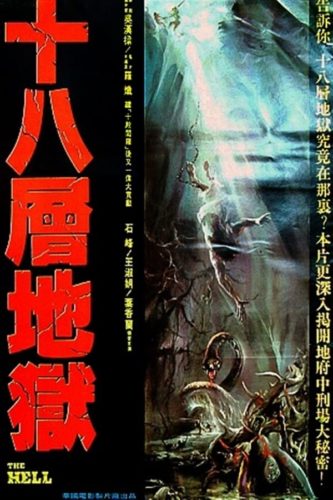 29. THE HELL (SHI BA CENG DI YU)
29. THE HELL (SHI BA CENG DI YU)
This would appear to be Taiwan’s answer to JIGOKU (1960), an evocation of a distinctly Buddhist conception of Hell. The Buddhist inferno has eighteen levels, at least fifteen of which are missing from the Hell depicted in this film. Set in Feudal times, it features a swordsman whose sister is dragged off by demons in a strange village that is in fact a portal to the underworld. The swordsman descends into Hell, where we see people dissolved in a lake of acid, eaten by a giant snake, drawn and quartered, burned, disemboweled, impaled and decapitated, presented via special effects that are almost passable. At just 75 minutes the whole thing feels a bit scant, but it certainly can’t be said to overstay its welcome. Plus, as with most East Asian fantasy fare of the period, it features a soundtrack comprised of music taken from other movies; I noticed a couple lifts from the Tangerine Dream SORCERER soundtrack, and also the theme from CHARIOTS OF FIRE.
28. SPECIAL SILENCERS
A prime example of cinematic junk food: utterly disposable, completely lacking in any redeeming value nutritional or otherwise, probably bearing dangerous side-effects and utterly irresistible. An Indonesian production, it stars that country’s prime action star Barry Prima as a martial arts minded muscle-head taking on a corrupt politician, who utilizes magic pills that can render one’s skin impenetrable to knives and bullets (but not bamboo!) or cause a tree to take root inside the innards and burst out through the torso. The latter occurrence is far more prevalent than the former, resulting in numerous ALIEN-like scenes of peoples’ chests bursting and sprouting. We also get plenty of overwrought Kung fooey of the type in which the film’s director, the late Arizal (THE STABILIZER), specialized, and a memorable turn by Asian action movie queen Eva Arnaz.
27. LITAN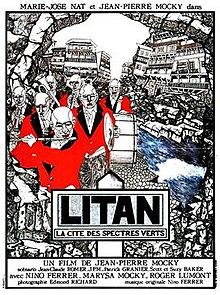
From the French weird movie auteur Jean-Pierre Mocky, a surreal fest set in a village where the laws of nature have apparently been suspended. Among the weirdness on display are people who wear odd masks, dead folk who walk around as if they’re still alive and a mad scientist who performs amoral experiments on people, with a strong suggestion that it might all be part of somebody’s dream. What precisely is LITAN “about?” Truthfully I’m not entirely sure—and yes, I did watch the film with English subtitles. It is undeniably compelling, although it could have used a more expressive visual palette a la David Lynch or Ken Russell.
26. VICE SQUAD
This, the third feature by England’s Gary Sherman (following RAW MEAT and DEAD & BURIED), is a good, trashy suspensor. Of course it’s a bit silly by modern standards, with the early 1980s fashions and hair styles dating the proceedings considerably, yet the overall atmosphere of big city grit remains potent. It stars Season Hubley as a suburban-mom-turned-prostitute, tapped by vice squad cops to nab a scumbag (Wings Hauser) who gets his jollies by killing hookers. There follows plenty of R-rated nastiness, with Hauser amply demonstrating why he was one of the premiere movie psychos of the era, and the incomparable John Alcott proving (again) that he was one of the absolute finest cinematographers in the business.
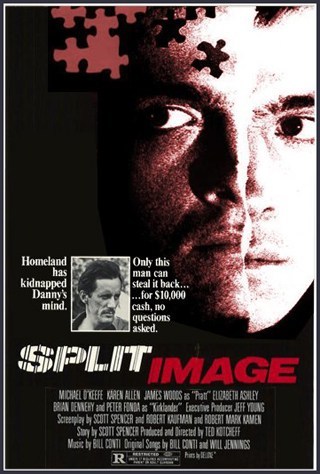 25. SPLIT IMAGE
25. SPLIT IMAGE
One of two nearly identical features about cults released in 1981-2 (the other was TICKET TO HEAVEN). According to these films, cults recruit their members—young white guys in both cases—by having a hot chick lure ‘em to a secluded hideout, where sleep is withheld and a relentless stream of propaganda is blared. Both films are hopelessly dated in terms of wardrobe, music and camerawork, although this is the better of the two. Michael O’Keefe is just okay in the lead role, but Peter Fonda is at his creepy best as the cult’s strangely charismatic leader, and James Woods is hilarious and (surprise!) not a little over-the-top as the deprogrammer who kidnaps O’Keefe and “cleans out” his mind. I also liked the near otherworldly domed landscape the cult calls home and an interesting PATTY HEARST-like section toward the end that subjectively visualizes O’Keefe’s confused psyche.
24. ANDROID
As far as low-budget 80’s sci fiers go, this one is close to the top. Borrowing talent from Roger Corman—including a young James Cameron, here credited as “Design Consultant”—it depicts a future world where Klaus Kinski as a mad scientist floats around in his deluxe space ship with a humanoid robot named Max (Don Keith Opper). Soon they’re joined by a band of rowdy interstellar travelers who force Max to confront his non-humanity in a variety of surprising and thought-provoking ways. It’s a somewhat cheesy flick, but Max is a fully rounded, sympathetic and even touching character, and the script is quite intelligent in the way it delineates the differences—and similarities—between humans and androids.
23. THE CHALLENGE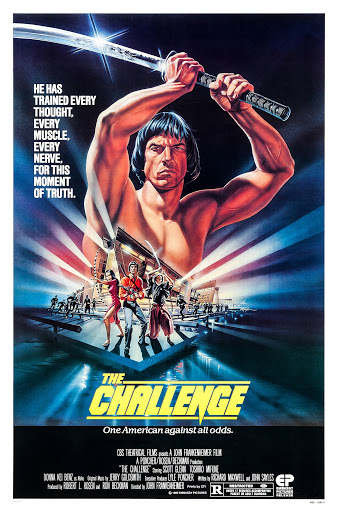
This American made martial arts blowout has been largely forgotten, but it’s a neat little film. Certainly it boasts an impeccable pedigree, having been directed by John Frankenheimer, co-scripted by John Sayles, starring the great Toshiro Mifune and featuring the vastly underutilized Hawaiian starlet Donna Kei Benz, who’s quite a sight as the female lead (also featured, FYI, was Steven Seagal as a martial arts coordinator). Scott Glenn co-stars as an American boxer who comes between Mifune and his yakuza brother (Atsuo Nakamura), each vying for control of two priceless swords. Lots of ass kicking ensues, as you might expect, and it’s all quite savage and diverting (albeit over-reliant on an obnoxiously bombastic Jerry Goldsmith score). The ending, for its part, is great, with one of the cinema’s more memorable head-splittings.
22. VIGILANTE
A huge hit on the grindhouse circuit, this sprightly DEATH WISH wannabe is pure trash movie bliss from start to finish. Robert Forster stars as a good-natured Brooklyn-based cop, whose son is killed by a nasty piece of street scum who gets a suspended prison sentence by a bleeding-heart judge. What to do? If you’re a fan of this type of fare you know the answer: take the law into your own hands and do away with the scum and the judge—and, while you’re at it, all the city’s bad guys! Fred Williamson as a guy who organizes neighborhood vigilante groups comes in mighty handy here, as does a ton of illegal firepower. William (MANIAC) Lustig was the director, and delivers the grindhouse goods with aplomb.
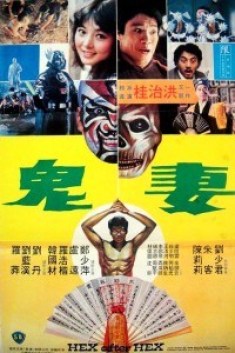 21. HEX AFTER HEX (XIE WAN XIE)
21. HEX AFTER HEX (XIE WAN XIE)
Here the Shaw Brothers, in a scary mood, sequalized HEX (1980). That film was a wild, if routine and derivative, DIABOLIQUE rip-off, and HEX AFTER HEX isn’t much better. It’s downright awful, in fact, but contains moments of mind-numbing asininity that attain a downright surreal pitch. In HEX AFTER HEX the unquiet spirit that powered the former film is brought back, but as a good guy, possessing the body of an attractive woman in order to take on corrupt businessmen. One of those businessmen gets stripped naked, pushed down the street in a baby carriage and branded with the Shaw Brothers logo. The ghost also turns into Darth Vader at one point, complete with a light saber it waves at people, which causes them to lose their clothes. It eventually goes on a rampage in a titty bar, after which an exorcist takes it on by animating a large statue and getting it to do whatever he does; the ghost turns the tables, however, by jabbing the statue in the crotch, thus causing the exorcist to feel a jab in his crotch, and somehow turning the statue into a slot machine that spews gold coins from its mouth, which on the exorcist translate to blood. I’m not making this up.
20. LADIES AND GENTLEMEN, THE FABULOUS STAINS
In most all respects this is a crappy product fully deserving of the truncated release it received. The film does, however, exude a definite time capsule charm in its depiction of the early 1980s punk scene, where a 15-year-old Diane Lane decides to start a band with her sister and cousin (the latter played by a 13-year-old Laura Dern). Diane Lane’s near-inhuman beauty is in full evidence, even if her acting leaves a bit to be desired; she comes off as more a whiney sourpuss than the charismatic rebel she’s supposed to be portraying. Lou Adler, whose first and only directorial effort this was, clearly had little aptitude for the job, yet the photography by Bruce Surtees is crisp and impressive, while Adler and Surtees’s collaborators (many of them taken from Robert Altman’s stable) drench the proceedings in naturalistic detail. Plus the always compelling Ray Winstone as Lane’s rival/love interest is as dangerously charismatic as ever.
19. WIR (WE)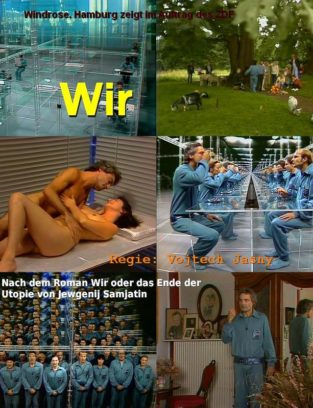
An admitted influence on George Orwell’s 1984, Yevgeny Zamyatin’s 1921 novel WE is often cited as the grandfather of futuristic dystopias. In this eminently faithful German TV movie adaptation, directed by Czechoslovakia’s late Vojtech Jasny, civilization has become a sterile and mechanized drudge, contained within dreary interior settings where collectivity is prized above all else. The protagonist (Dieter Laser) is an establishment drudge who upon developing feelings for a female troublemaker (Sabine von Maydell) decides to use his insider status to start a revolution. The film is distinguished by once-innovative blue screen effects, with actors performing before plainly unreal backgrounds that more often than not consist of endlessly repeating mirror images, as well as a creepy organ score and some surprisingly explicit sex and nudity. Plus the film has proven undeniably prophetic: note the line of dialogue “Walls are the greatest of man’s inventions,” a quote that had a very definite meaning in early-1980s Germany but has quite a different, though equally pertinent, one in post-2016 America.
18. SÓLEY
According to its late co-director Róska Óskarsdóttir, this Icelandic reverie “is about the dream and the reality that meet and go on a journey together.” Róska (1940–1996) was a famed avant-garde multi-media artist, and SÓLEY (co-directed with her spouse Manrico Pavelottoni) her only feature film. It embodies Róska’s abovementioned quote quite adequately, with an atmosphere that’s both gritty and hallucinatory, and filmmaking whose amateurishness actually compliments the subject matter, imparting a primitive feel that’s entirely appropriate to the 18th Century set narrative. It concerns a young man living in an especially rocky, mountainous part of Iceland whose horses are stolen. Setting off in search of his missing horses, the guy comes into contact with a number of strange people patterned on figures from Icelandic folklore, including a man bearing a laser beam-shooting sword and a red coat wearing woman who embodies all that’s good in this harsh landscape. Róska’s avant-garde bent is evident in the staunchly anti-authoritarian stance that pervades the film, with the religious leadership (represented by a pious scumbag who has his minions rob peoples’ homes while he stands ranting about the greatness of God) portrayed as corrupt and fascistic, and paganism viewed as a welcome reprieve.
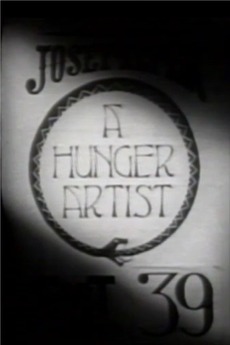 17. A HUNGER ARTIST
17. A HUNGER ARTIST
The second of two auspicious shorts by filmmaker John Strysik (the first being the H.P. Lovecraft inspired MUSIC OF ERICH ZANN). A fairly literal adaptation of Franz Kafka’s “A Hunger Artist,” the film concerns a spindly man (Robert Rothman) in a cage who fasts for days on end. A narrator informs us that in recent years interest in the “art” of fasting has waned, but back in the day the sight of a man starving was an extremely popular attraction. A circus manager orders the cage (and its occupant) cleaned out, but before this occurs the Hunger Artist reveals the secret of his art: “I never found a food I liked.” Shot in expressionistic black and white, it’s a stately film that’s quite deliberately paced and edited. The early 20th Century period details are convincing, and the filmmaking (excepting a somewhat distracting slow pan in the opening scenes) impressive. Strysik also utilizes silent movie intertitles, which help in establishing an appropriately primitive and archaic aura.
16. 38 JANSKY UNITS
From the Winnipeg Film Group and designer/musician Jan Krocker, a completely mind-boggling short that took Canada’s underground film scene by storm. Over the course of a static three minute shot we’re shown a black leather clad, helmet-wearing individual twitching spasmodically to a new wave techno-beat. Next to this personage is a woman mannequin with some kind of gas mask on her face, and below her a featureless plastic head that flashes. Weird.
15. FAST-WALKING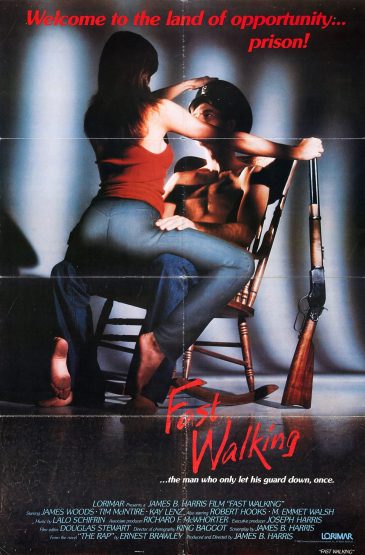
A nasty, quirky, politically incorrect raunch-fest from writer-producer-director James B. Harris. Harris is best known as Stanley Kubrick’s former partner, although there’s very little trace of Kubrick in this, a heist movie that will never be mistaken for THE KILLING. James Woods is at his sleaziest as “Fast-Walking” Miniver, a drug dealing, pot smoking prison guard who decides to help a convict escape in exchange for a hefty chunk of cash. Opposing him is a scheming inmate working out a myriad of questionable scams, played beautifully by Tim McIntire. He leads a supporting cast that’s an exploitation buff’s wet dream, with Timothy Carey, Susan Tyrell, M. Emmet Walsh, Sydney Lassick and Kay Lenz all taking their turn.
14. NEXT OF KIN
Australia’s answer to THE SHINING was this stylish and effective chiller. It features a young woman returning to her rural childhood home, as her mother has just died and bequeathed said home, which appears to be haunted. NEXT OF KIN is a disarmingly stately and refined work, far closer in tone to PICNIC AT HANGING ROCK or the abovementioned SHINING than AUSTRALIA AFTER DARK or MAD MAX. In the profoundly eerie sight of a levitating man outside the heroine’s window, and a close-up of a foot stepping on a drowned man’s head, director Tony Williams demonstrates a real flair for atmospheric horror. Of course, this is still very much an Ozploiter, meaning we get gratuitous sex, a shower scene, some fairly graphic gore and even some quintessentially Australian automobile action. But to dismiss NEXT OF KIN as a shallow splatter/exploitation movie, as many critics initially did, is plain wrong.
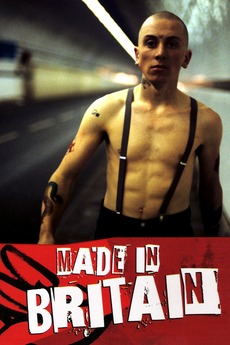 13. MADE IN BRITAIN
13. MADE IN BRITAIN
Another excellent, hard-hitting BBC drama by Alan Clarke. Tim Roth, in his screen debut, plays a good-for-nothing skinhead who gets put in a reform house; he quickly escapes, and after pissing on his files embarks on a rampage of destruction. Although made for television, this is a stunningly cinematic work, with groundbreaking steadicam photography by Chris Menges that in no way compromises the atmosphere of grimy realism at which Clarke excelled. Add to that a terrifically perceptive script by David Leland (the scene where a social worker outlines Roth’s life choices on a blackboard is a brilliant piece of screenwriting) and a blistering performance by Roth, and you’ve got one of the premiere British films of the decade.
12. INVITATION AU VOYAGE
New wave weirdness from France. A guy’s punk rock sis, with whom he had a “complex” relationship, dies, forcing him into a reevaluation of his life during which he puts her body in a guitar case, ties it to the roof of his car and embarks on an aimless trip around France; during this trip he meets lots of eccentric people, and is careful to put up posters for his late sister’s band wherever he goes. Writer-director Peter Del Monte (who also made the 1985 Kathleen Turner psycho-fest JULIA AND JULIA) delights in setting up expectations and then shattering them just when it seems the viewer has a handle on where things are heading. That and the superb photography (much of it illuminating ominous nocturnal gas stations and nightclubs) combine to create an eerie and compelling dreamscape I doubt I’ll be forgetting any time soon.
11. CALAMITY OF SNAKES (REN SHE DA ZHAN)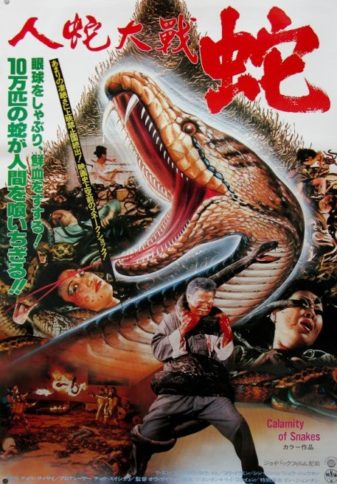
I’m opposed to the real-life snake killings in this Hong Kong cinemutation, but otherwise I love the film, surely one of the most cheerfully berserk of all time. It’s an example of exploitation cinema boiled down to its sublimely trashy essence, with a pit of snakes discovered on a building sight and mashed up. This causes the apartment constructed on the sight to be cursed, resulting in an invasion of killer snakes. Among the mayhem that ensues is a lovemaking couple getting bitten to death, a woman attacked by snakes in her bathtub, an ancient magician engaging in a Kung fu battle with a giant cobra, that same cobra engaging in its own battle with cops by leaping around and flinging things at ‘em, and a dance party interrupted by masses of snakes in an outrageous variant on the elevator scene from THE SHINING.
10. VARIOLA VERA
As of 2020 we’re all experts on pandemic cinema, and this Yugoslavian made dramatization of a 1972 smallpox epidemic that occurred in Belgrade is among the better such films. The setting is a hospital where a severely ill man is admitted; he has variola (Latin for smallpox), and in short order the hospital is quarantined, much to the consternation of the patients and staff trapped inside. The surviving prints of VARIOLA VERA are marred by faded colors and scratched-up film stock, but director Goran Markovic’s artful visual eye shines through (a magisterial tracking shot through a hallway lined with smallpox afflicted patients remains a standout visual moment). Despite the horror movie trappings (such as the ominous music cues used to announce the possibility of smallpox infection) and air of overheated melodrama, this is a realistic portrayal of a disease outbreak that takes into account the media portrayal of the event and the political ramifications. Plus the make-up effects, depicting the ravages of variola on peoples’ faces and bodies, are horrifically impressive.
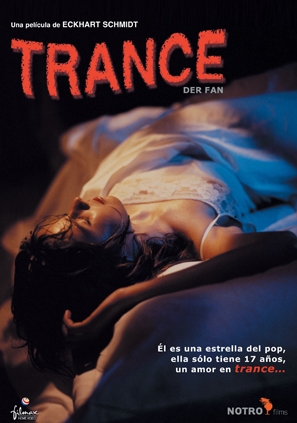 9. TRANCE (DER FAN)
9. TRANCE (DER FAN)
This German sickie is the last word on celebrity stalking. It features a young woman (Desiree Nosbusch) obsessed with a rock star known only as “R.” When R doesn’t answer her fan mail she worms her way into his inner circle, leading to a night of sex and, when R attempts to discard Nosbusch, a riot of perverse eroticism and gore. One’s enjoyment of this movie depends, first and foremost, upon a willingness to put up with the outrageously dated new wave music that pervades at least an hour’s worth of the soundtrack. Also, some of the narrative developments are less than believable, particularly the fact that R so readily invites the mentally unbalanced Simone into his fold. Yet the final half hour, presented largely without dialogue, is genuinely horrific, and unfolds in as morbidly atmospheric a manner as can be imagined. Director Eckhart Schmidt doesn’t skimp on the gruesome details, which thanks to the unerringly assured style and atmosphere never seem gratuitous or out of place.
8. WOLF DEVIL WOMAN (LANG MU BAI MO)
Yet another terminally nutty Hong Kong horror fest. It’s about a couple who escape a forest-dwelling cult of satanic magicians; for this the couple are tracked down and killed, but manage to bury their baby girl in snow beforehand. A wolf later digs the child up and takes her to an underground ice palace, where she grows into HK martial arts superstar Cheung Ling (who also directed). This gal likes to bark, leap through the air and rip chickens apart—eventually, though, she goes after the cultists who killed her folks, leading to a climax so unspeakably brain-fried it looks like it was shot by Alejandro Jodorowsky on steroids. There’s enough ass-kicking here to fill a dozen standard martial arts flicks, along with copious magic and gore; this is certainly the only movie I’ve ever seen in which the heroine jabs herself in the arm and puts out a fire with her own blood!
7. DEADLOCK (HOLTPONT)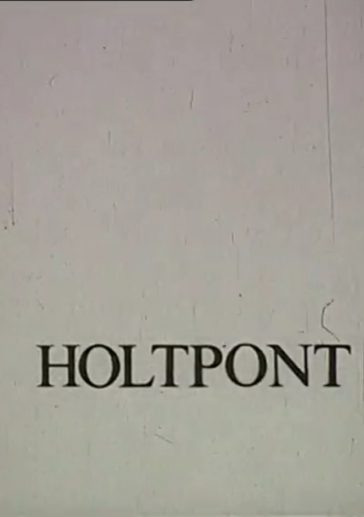
This animated short from Hungary is only four minutes long, but they’re among the most impacting four minutes I’ve ever experienced. In conception and execution DEADLOCK is quite simple, depicting, through unshowy black and white animation, the POV of a condemned prisoner stuck in a horrific walled enclosure. It opens with a view of a dripping Fawcett and moves upward to examine the bleak surroundings. Eventually a man places a blindfold over the camera and the POV moves down to peer through two tiny nose holes at the prisoner’s shoes, as a fly lands on them and an off-screen gunshot is heard. This was one of several animated shorts directed by Ferenc Rofusz, who offers no dialogue or scene setting, presenting the imagery entirely without text (con or sub) of any sort, and the film, brief though it is, is all the more powerful for that.
6. WITCH WITH FLYING HEAD (FEI TAUGH ME NEUIH)
The title essentially tells the story of this Hong Kong made extravaganza, about a woman living in some unspecified feudal era invaded by a malevolent serpent that slithers up her vagina, causing her to become a krasue—meaning her head periodically lifts itself off her body, with the innards attached, to become a gravity-defying blood-drinker. In this way director Lian Sing Woo combines South Asian mythology with the invasive serpent motif popular in Hong Kong films of the time (see KILLER SNAKES, LEWD LIZARD, etc.), but the flying head of this film can do other cool things like shoot lasers from its mouth and breathe fire. There’s a cult of magical snake people afoot in the town, many of whom want the witch’s head (pun intended), leading to an FX showdown of near-indescribable insanity. Note the requisite eel barfing and martial arts action we’ve come to expect from HK horror flicks, and special effects that are fairly impressive considering the tawdriness of the production.
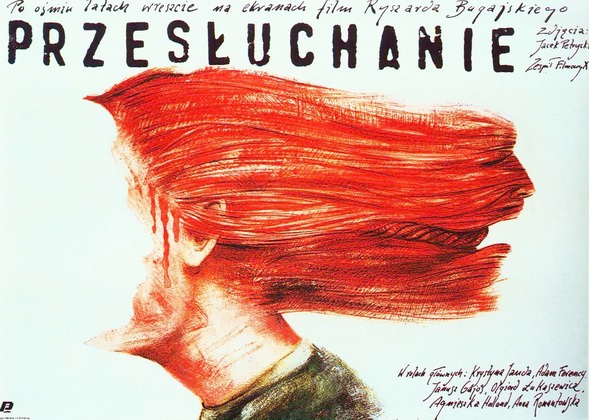 5. INTERROGATION (PRZESLUCHANIE)
5. INTERROGATION (PRZESLUCHANIE)
An ultra-gritty Polish prison drama that was banned for nearly a decade, this is essentially a woman-centric version of MIDNIGHT EXPRESS. It’s a defiantly angry and disturbing film, with a young singer (Krystyna Janda, Poland’s top actress) getting hauled off to prison one night for a crime that’s never revealed. A grueling series of Kafkaesque interrogations follow, along with various tortures and indignities. Janda is GREAT throughout, and director Richard Bugajski imparts a horrifically convincing sense of stark and unforgiving reality.
4. SHOOT THE MOON
This isn’t the movie Pauline Kael (who raved about it unreservedly) thought it was, but it is damn good. I’d say it’s the best entry in the divorce movie craze of the early 1980s (which included KRAMER VS. KRAMER, ORDINARY PEOPLE, SMASH PALACE and MY FIRST WIFE), a keenly observed, painful and complex drama about the extremely contentious break-up of an affluent Northern California couple. Albert Finney is at his best as George, a transplanted English writer with a hair-trigger temper, and Diane Keaton has never been better than she is as his long-suffering wife Faith. All the actors are great, down to supporting players like the late Dana Ivey as George and Faith’s sensitive teen daughter and Peter Weller as Faith’s redneck suitor. Speaking of people at the top of their game, Alan Parker’s direction is (mostly) pitch perfect in creating a disarmingly quiet ambiance of unspoken pain and bitterness that boils over in several laceratingly violent sequences. The ending, I feel, ties everything up a bit too neatly (especially since the film is otherwise so messy and complicated), being a serious point of contention in an otherwise impeccable tapestry.
3. DISCO DANCER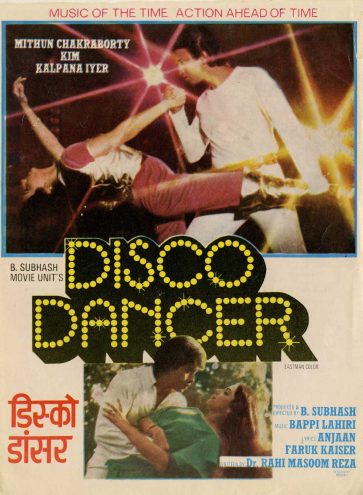
This Bollywood outrage, made 3-5 years after the disco craze peaked in most of the world, can be viewed as India’s answer to CAN’T STOP THE MUSIC. Mithun Chakraborty is unforgettable as Jimmy, who as a child witnesses his mother humiliated and unjustly imprisoned by the assholish Mr. Oberi (Om Shivpuri). Jimmy grows up to become a professional disco dancer and falls in love with Oberi’s daughter (the imminently watchable Kim), which of course complicates his revenge plot considerably. Further setbacks occur when Jimmy’s beloved mother is killed by an electrified guitar (a device intended for Jimmy), leaving him with Guitar Phobia, and his legs are broken by Oberi’s goons. Will Jimmy be able to make his way to the stage to perform a climactic disco dance and wreak his revenge? I wouldn’t dream of revealing the answer. The film is quite choppy (the print I viewed clearly underwent heavy postproduction editing) yet irresistibly batty, with some of the most elaborate disco dancing sequences I’ve ever seen, a narrative that continually tops itself in outrageousness, several surprisingly brutal fight scenes, and quite a few impossible-to-forget tunes (none more so than the opening song, with its refrain “D!! I!! S!! C!! O!!…Dis-co Dan-cer!! Dis-co Dan-cer!! Dis-co Dan-cer!!”).
2. L’ANGE (ANGEL’S FLIGHT)
An animated opus from France’s Patrick Bokanowski that consists of a POV shot up a winding set of stairs, intercut with the activities of the many strange figures inhabiting the area. These include a guy who pokes at a hanging dummy with a sword, a maid who continually delivers a seated man a pitcher of milk that always spills, and a bunch of suit-wearing fellows in Michael Meyers masks working in a vast library. It concludes with a literal ascent to Heaven by several indistinct figures up a vast set of floating steps, with blinding white light shining down upon them (an image, I might add, that looks nearly identical to a climactic scene in TIME BANDITS). I’ve no idea what any of this might “mean,” but it’s an incredible visual experience, interweaving animation, puppetry and live action in a gorgeously filmed, haunting and profoundly mysterious fantasia.
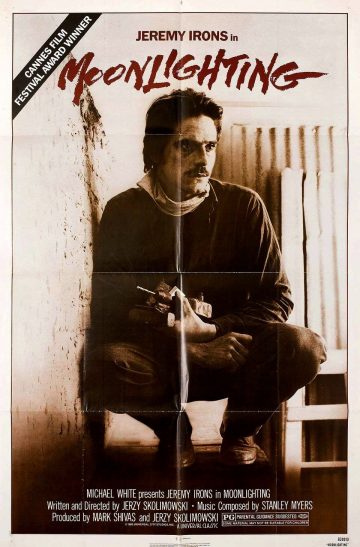 1. MOONLIGHTING
1. MOONLIGHTING
Not to be confused with another 1980s product bearing the same name, this is Polish director Jerzy Skolimowski’s masterpiece, a modestly mounted yet mind-blowing film set in England around the time of the 1981 communist overthrow of Poland. Apparently Skolimowski was in the UK working on another project in ‘81, but upon hearing about the troubles in his native land immediately dropped it and rushed the present film into production. It stars Jeremy Irons, in one of his best-ever performances as the jittery leader of a band of Polish workers stationed in England to fix up their boss’s flat. The boss is using the Polacks to save money (and courting Irons’s wife back in Poland), with Irons the only one of them who can speak English. He uses that to his advantage, as upon learning of the Polish coup he convinces the others that everything is still okay back home. He also resets their watches to get them to work longer days, and keeps them locked inside the flat, thus precipitating his own form of martial law. Skolimowski directs this eccentric account with great skill, capturing the crushing isolation of the protagonists’ situation with disquieting vividness while serving up a great deal of naturalistic comedy, with Irons getting into a number of wacky situations as his money runs out and he finds himself trying to scam food from a supermarket and clothes from a department store. An amazing film: spare, funny and, finally, devastating.
